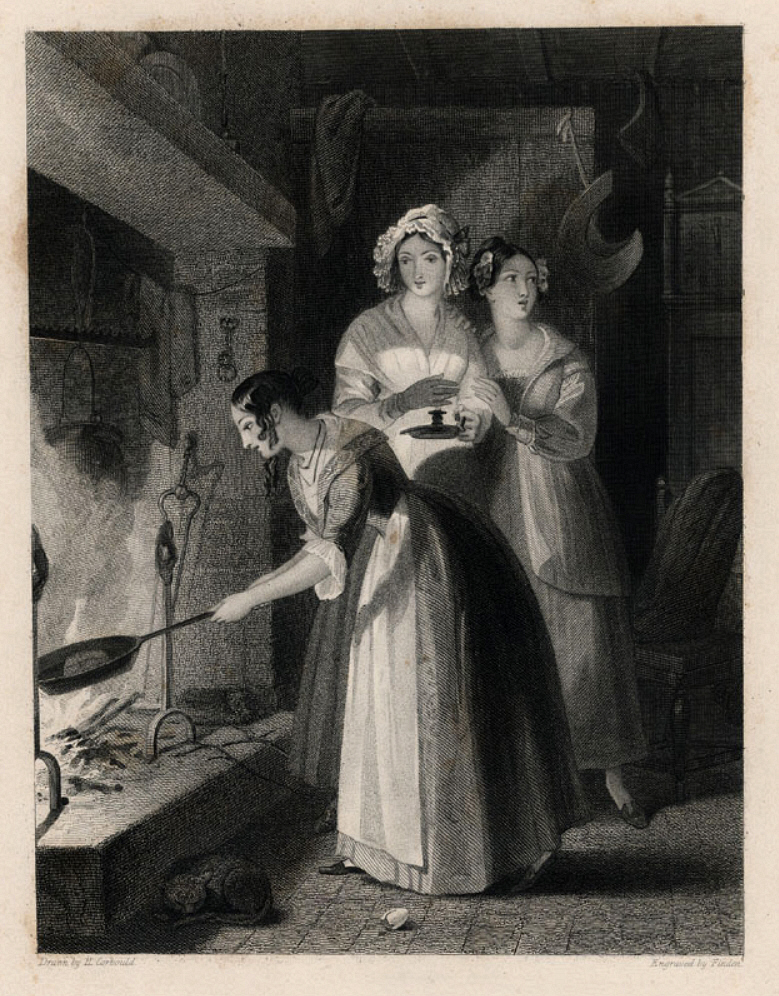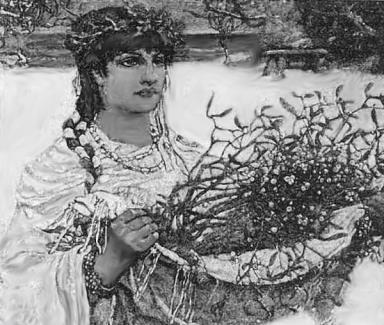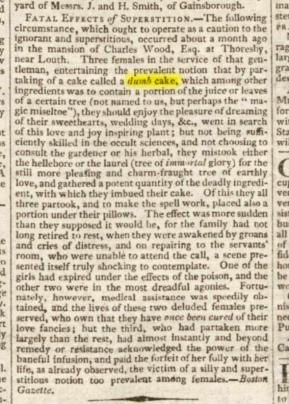

|
 A cake made on an auspicious day (St. Mark’s Eve (April 24th), St Agnes Eve (January 20th) Midsummer’s Eve or Halloween) with numerous ceremonies, by spinster maids, to discover their future husbands. The name may derive from the middle English ‘doom’ meaning ‘fate’ or ‘destiny’.  The Dumb-Cake Baking Print by W. Finden, c1843 The Rev. M.C.F. Morris, in his ‘Yorkshire Folk Talk‘ of 1892, tells that “The proper day for making Dumb Cake was the eve of St. Agnes. What all the ingredients of the cake were I know not, but one principal one was salt. I remember being told some years ago, by an old inhabitant in one of the dales, about the composition of this mystic cake. It was somewhat as follows: In the first place four people had to assist in the making of it, each taking an equal share in the work, adding small portions of its component parts, stirring the pot, and so forth. During the whole time of its manufacture and consumption a strict silence has to be observed. Even when it is being taken out of the oven each of the interested parties must assist in the work. When made it is placed on the table in the middle of the room, and the four persons stand at the four corners of the room. When set on the table the cake is divided into equal portions and put upon four plates or vessels. The spirit of the future husband of one of the four would then appear and taste from the plate of his future bride, being only visible to her whose husband he was destined to be. As a preliminary to this, every door of the house had to be thrown open. The traditional hour for making the feast was midnight.”  St Agnas Most records suggest a very plain cake indeed. The ‘Evening Telegraph‘ on Thursday 21 June 1928 says; “A ‘dumb cake’ was a concoction of water, flour, sugar, and salt, and no other ingredient, and absolute silence had to be maintained throughout the entire operation. The next condition was that two must make it, two must bake it, and two must break it.”  The Druid Preistess Bringing Mistletoe From Christmas: Its Origin and Associations, 1902 But it might also have remarkable ingredients. It is possible that Dumb Cake is a remnant of ancient shamanic or ‘Druidic’ ritual where the visions of future husbands were helped-out by the addition of hallucinogenic herbs such as mistletoe. A possibility heightened by the fact that the Dumb Cake is associated with another well-known spinster’s ritual of planting Cannabis hemp… Miss Arabella Whimsey recalled in the ‘Leeds Mercury‘ (Thursday 29 September 1870); “I shall never forget what I did last Midsummer-eve. I and my two sisters tried the dumb-cake together: you must know, two must make it, two bake it, two break it, and the third put it under each of their pillows, but you must not speak a word all the time, then you will dream of the man you are to have. This we did; and to be sure I did nothing all night but dream of Mr. Blossom. The same night, exactly at twelve o’ clock, I sowed hemp-seed in our backyard, and said to myself: “Hemp-seed I sow, hemp-seed I lies, and he that is my true love come after me and mow!” Will you believe me? I looked back and saw him behind me, as plain as eyes could see him.” This could be unfortunate if you lived in the modern period where the ritual was only half-remembered and the ingredients largely forgotten, as in this report from 1813…  Fatal effects of ill-made Dumb-Cake Stamford Mercury – Friday 19 February 1813 ‘Weather and Folk Lore of Peterborough and District.‘ by Charles Dick (1911) has; “Dumb Cake. On Midsummer Eve three girls are required to make a dumb cake. Two must make it, two bake it, two break it, and the third put a piece under each of their pillows. Strict silence must be preserved. The following are the directions given how to proceed: The two must go to the larder and jointly get the various ingredients. First they get a bowl, each holding it and wash and dry it together. Then each gets a spoonful of flour, a spoonful of water and a little salt. When making the cake they must stand on something they have never stood on before. They must mix it together and roll it. Then they draw a line across the middle of the cake and each girl cuts her initials each on opposite sides of the line. Then both put it into the oven and bake it. The two take it out of the oven, and break it across the line and the two pieces are given to the third girl who places a piece under each pillow and they will dream of their future. Not a word must be spoken and the two girls after giving the pieces to the third girl have to walk backwards to bed and get into bed backwards. One word or exclamation by either of the three girls will break the charm. Should a gale arise and the wind appear to be rustling in the room, during the baking or latter part of the preparation, if they look over their left shoulder they will see their future husbands. In some districts the pieces of cake are eaten in bed and not put under their pillows but nothing must be drank before breakfast next morning. Another variation is that two only make the cake and go through the same form as the preceding, only they divide it themselves, then each eats her portion and goes to bed backwards as in the first case and nothing must be drank or a word spoken. An uncooked dried salt fish eaten before going to bed in silence and walking backwards and getting into bed the same way, causes ones future husband to appear in a dream with a glass of water in his hand if a teetotaller, or a glass of beer if he is not one. Nothing must be drank before breakfast. An old woman said she had tried it over 40 years ago and her husband brought her a glass of beer and he was not an abstainer but rather the reverse.” Thanks to Nic Wilkinson for pointing out that John Keats chilling poem ‘The Eve of St. Agnes‘ includes the lines.. They told her how, upon St. Agnes’ Eve, See also: Dumb Cake Kattern Cake Spinster’s Cake St Agnes Pudding For other seasonal traditions, see: Halloween  |
|
MORE FROM Foods of England... Cookbooks ● Diary ● Index ● Magic Menu ● Random ● Really English? ● Timeline ● Donate ● Royalty ● English Service ● Food Map of England ● Lost Foods ● Accompaniments ● Biscuits ● Breads ● Cakes and Scones ● Cheeses ● Classic Meals ● Curry Dishes ● Dairy ● Drinks ● Egg Dishes ● Fish ● Fruit ● Fruits & Vegetables ● Game & Offal ● Meat & Meat Dishes ● Pastries and Pies ● Pot Meals ● Poultry ● Preserves & Jams ● Puddings & Sweets ● Sauces and Spicery ● Sausages ● Scones ● Soups ● Sweets and Toffee ● About ... ● Bookshop ● Email: [email protected] COPYRIGHT and ALL RIGHTS RESERVED: © Glyn Hughes 2022 BUILT WITH WHIMBERRY |